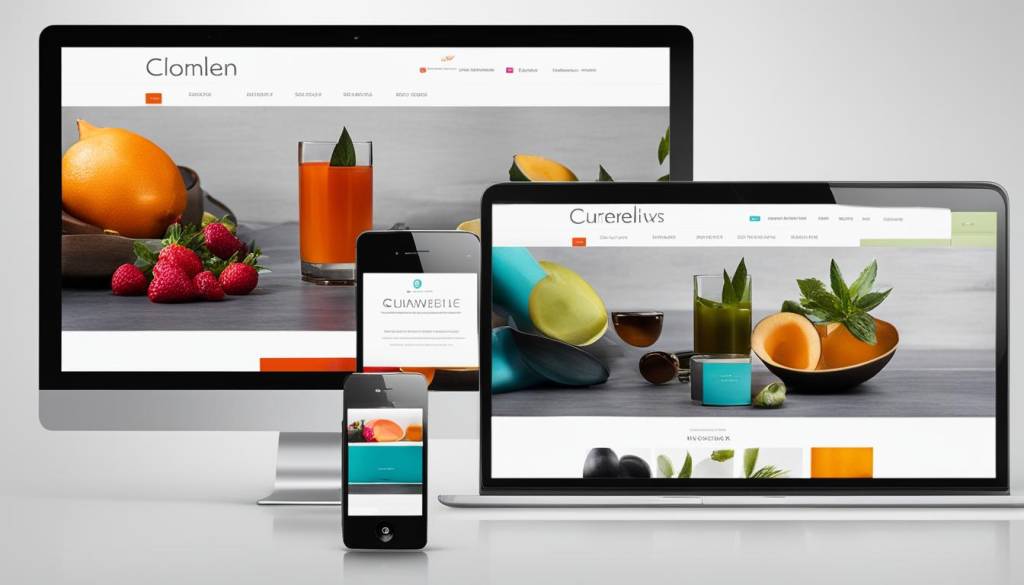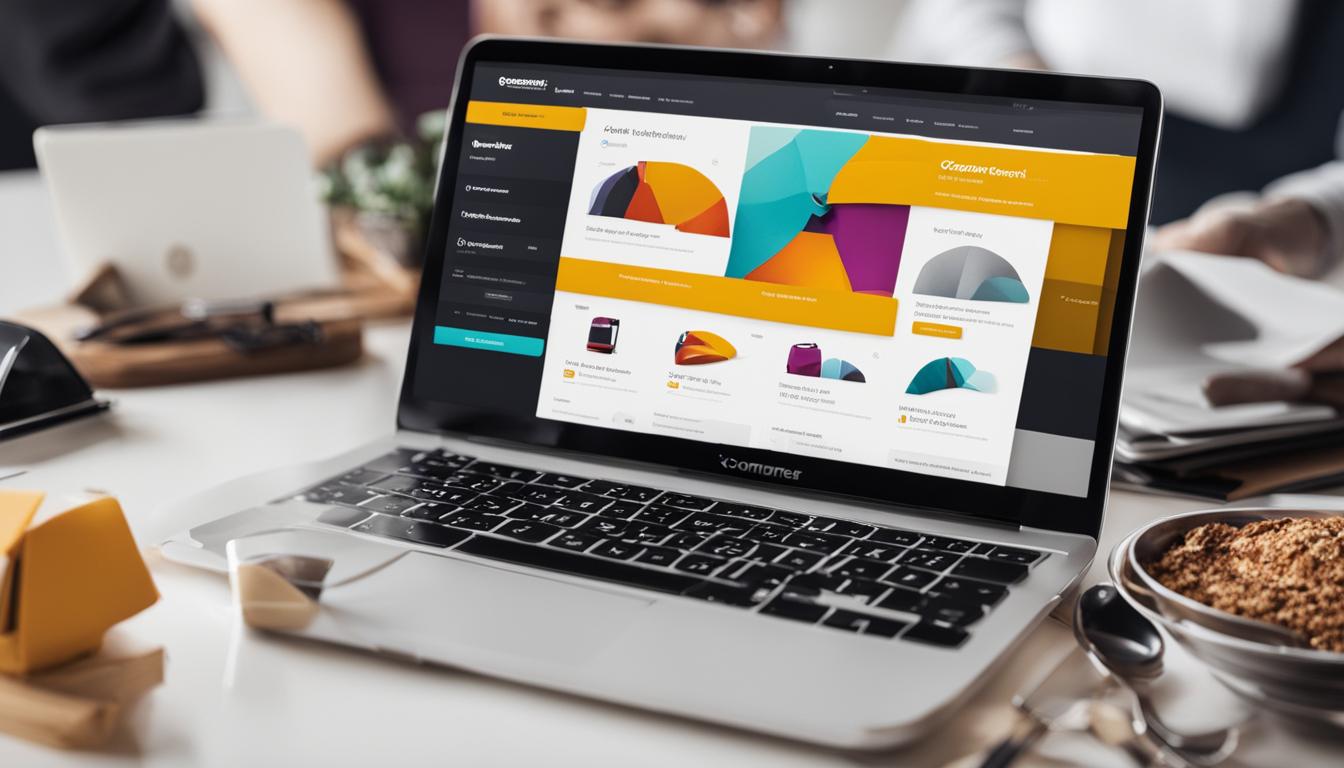In order to increase sales, revenue, and profits in your WooCommerce store, there are specific strategies you can implement. By focusing on these optimization strategies, you can improve the efficiency of your e-commerce site and watch your online sales soar. Whether you sell physical or digital products, these strategies are applicable for almost every WooCommerce store. Implementing these strategies one at a time over the course of a year can help you see significant improvements in your sales.
Key Takeaways:
- Implementing WooCommerce optimization strategies can boost your online sales.
- Optimize page loading speed to reduce bounce rates and improve user experience.
- Simplify the checkout process to increase conversion rates.
- Enhance the user experience with a responsive design and easy navigation.
- Utilize email marketing to communicate with potential and existing customers.
Boost Your Page Loading Speed
Page loading speed is crucial for an e-commerce site. Slow loading times can lead to increased bounce rates and abandoned carts, negatively affecting your online sales. To ensure that your WooCommerce store loads quickly and efficiently, there are several optimization techniques you can implement:
- Test your current site speed using tools like GTmetrix and Google PageSpeed. These tools provide insights into your site’s performance and suggest specific optimizations.
- Use a lightweight and optimized theme. Themes with clean code and minimal design can help improve loading speed.
- Optimize your images by compressing them without compromising quality. Use plugins like Smush or Imagify to automatically optimize your images.
- Implement caching techniques to reduce server load and deliver content faster to your visitors. Plugins like WP Rocket or W3 Total Cache can help with this.
- Minify and combine CSS and JavaScript files to reduce the number of server requests. This can be done using plugins like Autoptimize or WP Super Minify.
“A fast-loading website is essential for a seamless user experience and improved conversion rates. By implementing these best practices, you can enhance your customers’ browsing experience and increase the chances of making a sale.”
Optimizing Images for Faster Loading
Images play a significant role in the visual appeal of your online store, but they can also contribute to slower loading times. To optimize your images for faster loading:
- Resize your images to the appropriate dimensions for web display. Use image editing software or plugins like Regenerate Thumbnails to ensure your images are not larger than necessary.
- Compress your images without compromising quality. Plugins like ShortPixel or EWWW Image Optimizer can automatically compress your images during the upload process.
- Use lazy loading techniques to load images only when they are visible on the user’s screen. This can significantly improve initial page load times.
Implementing these image optimization techniques can help reduce the file size of your images, resulting in faster page loading speed and a better user experience.
Improve the Checkout Process
The checkout process is a critical part of the sales process, and optimizing it can significantly impact your conversion rates. Simplifying the checkout process can help reduce cart abandonment and increase the number of completed purchases. Here are some proven tips and tricks to optimize your WooCommerce store’s checkout process:
- Remove unnecessary fields: Streamline the checkout process by eliminating any unnecessary form fields. Only ask for essential information such as name, shipping address, and payment details. The fewer fields customers have to fill out, the more likely they are to complete the purchase.
- Offer multiple payment options: Provide customers with a variety of payment options to cater to their preferences. Accept popular payment methods like credit cards, PayPal, Venmo, and digital wallets. Giving customers flexibility in how they pay can increase trust and encourage them to proceed with the purchase.
- Allow guest checkout: Avoid forcing customers to create an account or log in before they can make a purchase. Offering a guest checkout option allows customers to complete their purchase quickly without the hassle of creating an account. You can still provide an option for customers to create an account after their purchase is complete.
- Incentivize with free shipping or promotions: Consider offering free shipping or special promotions during the checkout process to incentivize customers to complete their purchase. Free shipping can help reduce cart abandonment and increase the perceived value of the purchase.
By implementing these conversion rate optimization strategies, you can create a smoother and more user-friendly checkout process for your WooCommerce store. Remember to continuously monitor and analyze your checkout funnel to identify any potential bottlenecks or areas for improvement. Making the checkout process as seamless as possible will ultimately lead to higher conversion rates and increased sales.
Customer Testimonial:
“I love how easy and quick the checkout process is on this WooCommerce store. The option to check out as a guest, along with multiple payment methods, makes it convenient for me to complete my purchase without any hassle. Plus, the free shipping incentive is a great bonus!” – Happy Customer
Enhance User Experience
When it comes to running a successful WooCommerce website, providing an exceptional user experience should be one of your top priorities. By optimizing the user experience, you can maximize the potential of your WooCommerce store and increase conversions. Here are some best practices to help you enhance the user experience on your website:
1. Organize Products with Clear Categories
Make it easy for users to find what they are looking for by organizing your products into clear and logical categories. This allows visitors to navigate through your store effortlessly and locate the products they are interested in. Use descriptive category names and consider implementing a drop-down menu or sidebar navigation to further enhance the browsing experience.
2. Implement a Responsive Design
In today’s mobile-driven world, having a responsive design is crucial for maximizing the user experience. Ensure that your WooCommerce store is optimized for various screen sizes and devices. This means that your website should adapt and display seamlessly on smartphones, tablets, and desktop computers, providing users with a consistent and enjoyable browsing experience regardless of the device they are using.
3. Improve Search Functionality
A robust search feature with advanced filters can greatly enhance the user experience on your WooCommerce store. Utilize plugins like Jetpack Search to improve the search functionality, allowing users to easily find specific products based on their preferences or criteria. By providing an efficient search experience, you can save users time and improve their overall satisfaction with your website.

4. Provide Detailed Product Information
High-quality product photos and clear descriptions are essential for creating a positive user experience. Ensure that each product page includes compelling photos that showcase the product from different angles and provide users with a clear understanding of its features and benefits. Include relevant information such as product dimensions, materials, and usage instructions to help users make informed purchasing decisions.
By implementing these user experience best practices, you can maximize the potential of your WooCommerce website and create a positive impression on your visitors. Remember, a great user experience can lead to higher conversion rates and increased customer satisfaction.
Utilize Email Marketing
Email marketing is a powerful tool for maximizing sales in your WooCommerce store. By building an email subscriber list, you can communicate with potential and existing customers, sending them new product announcements, first-time customer discounts, referral rewards, abandoned cart emails, holiday campaigns, and more.
One of the key tips for successful email marketing is to provide value to your subscribers. Instead of bombarding them with constant sales pitches, offer helpful and informative content that is relevant to their interests. This could include product tutorials, industry insights, or exclusive tips and tricks. By providing value, you can build trust and credibility with your subscribers, increasing the likelihood of them making a purchase.
Another effective strategy is to segment your email list based on customer behavior and preferences. This allows you to send targeted, personalized messages that resonate with specific segments of your audience. For example, you could create separate email campaigns for first-time customers, loyal customers, or customers who have recently abandoned their carts. By tailoring your messages to each segment, you can increase engagement and conversion rates.
Create Compelling Email Content
When creating your email content, it’s important to make it visually appealing and easy to read. Use catchy subject lines that grab attention and entice subscribers to open your emails. Incorporate high-quality images that showcase your products and include clear calls to action (CTAs) that prompt recipients to take the desired action, such as making a purchase or visiting your store.
“Email marketing is a cost-effective way to reach your target audience and drive sales. With the right strategy and compelling content, you can turn email subscribers into loyal customers.”
Additionally, make sure your emails are mobile-friendly. The majority of people check their emails on their smartphones, so it’s essential that your emails are easily readable on smaller screens. Test your emails across different devices and email clients to ensure a seamless experience for all recipients.
Remember to analyze the performance of your email campaigns using metrics such as open rates, click-through rates, and conversions. This data will provide insights into what’s working and what can be improved, allowing you to optimize your email marketing strategy over time.
The Power of Automation
Automation is a game-changer in email marketing. By setting up automated workflows, you can deliver targeted messages based on specific triggers or customer actions. For example, you can automatically send a welcome email series to new subscribers, follow up with abandoned cart reminders, or send personalized recommendations based on previous purchases.
Automation not only saves you time but also ensures that your customers receive timely and relevant messages, increasing the chances of conversions. With plugins like MailPoet specifically designed for WooCommerce stores, you can easily set up and manage automated email campaigns directly from your WordPress dashboard.
Optimize for Search Rankings
When it comes to running a successful WooCommerce store, optimizing for search rankings is crucial. By implementing effective SEO strategies, you can increase your organic traffic and visibility, ultimately driving more sales and conversions. Here are some key tips and tricks to optimize your WooCommerce store for search rankings:
1. Conduct Keyword Research:
Start by conducting thorough keyword research to identify relevant and high-converting keywords for your products and categories. Use tools like Google Keyword Planner and SEMrush to find popular search terms and competition levels. Incorporate these keywords naturally into your product descriptions, titles, URLs, and meta tags.
2. Optimize Product Pages:
Each product page should have a unique and descriptive title tag, meta description, and URL. Incorporate your target keywords strategically without overstuffing. Use header tags (h3) to structure your page content and make it more readable for both search engines and users.
3. Earn Backlinks:
Building high-quality backlinks is a crucial aspect of SEO. Reach out to influential bloggers and industry websites in your niche to request backlinks. Guest posting on relevant blogs and participating in online forums and communities can also help you build valuable backlinks to your WooCommerce store.
“Optimizing your WooCommerce store for search rankings is not a one-time task—it requires ongoing effort and analysis. Stay updated with the latest SEO trends and algorithms to ensure your store remains competitive in search engine results.”
By following these SEO tips, you can improve the visibility of your WooCommerce store in search engine results and attract more organic traffic. Remember, SEO is an ongoing process, so regularly monitor your store’s performance, analyze keyword rankings, and make necessary adjustments to stay ahead of the competition.
Implement Responsive Web Design
With the increasing use of mobile devices for online shopping, it is essential to implement responsive web design in your WooCommerce store. A responsive design ensures that your website is optimized for various screen sizes, providing a seamless and user-friendly experience for your customers. By making your store mobile-friendly, you can improve your search rankings and attract a larger audience, ultimately maximizing your WooCommerce website’s potential.
Responsive design allows your website to adapt to different devices, such as smartphones, tablets, and desktop computers. This means that regardless of the device your customers are using, they will be able to easily navigate your store, browse products, and make purchases. Responsive design eliminates the need for users to zoom in or scroll horizontally, enhancing the overall user experience and making it more likely for them to stay on your website.

Implementing responsive web design in your WooCommerce store involves using a combination of flexible grids, layouts, and media queries. These techniques allow your website to automatically adjust its layout and content based on the device’s screen size. It is crucial to choose a responsive theme or customize your existing theme to ensure that your store looks and functions perfectly on all devices.
“Implementing responsive web design in our WooCommerce store has proven to be a game-changer. Our mobile traffic has significantly increased, and our customers love the seamless experience across devices. It has also had a positive impact on our search rankings, boosting our visibility in mobile search results.” – John, WooCommerce store owner
By implementing responsive web design, you can ensure that your WooCommerce store is accessible and user-friendly for all visitors, regardless of the device they are using. This not only improves the overall user experience but also helps boost your search rankings and maximize your WooCommerce website’s potential.
Monitor and Analyze Store Performance
Monitoring and analyzing the performance of your WooCommerce store is essential for optimizing its success. By tracking key metrics and analyzing data, you can identify areas of improvement and make data-driven decisions to maximize your store’s performance.
One of the most valuable tools for monitoring store performance is WooCommerce Analytics. This feature-rich tool provides comprehensive insights into your store’s sales, conversion rates, traffic sources, and more. With WooCommerce Analytics, you can easily track and analyze key metrics, allowing you to identify trends and patterns that can help you optimize your store’s performance.
Analyzing your store’s performance data can provide valuable insights into your customers’ behavior, allowing you to make informed decisions to improve your store’s performance. For example, you can identify which products are selling well and which ones may need additional promotion or optimization. You can also track the effectiveness of marketing campaigns and promotional activities, helping you allocate resources more effectively.
By monitoring and analyzing your store’s performance, you can identify opportunities for growth and make data-driven decisions to optimize your store. WooCommerce Analytics provides valuable insights into your store’s sales, conversion rates, and traffic sources, allowing you to make informed decisions to improve your store’s performance.
Secure Your WooCommerce Store
Ensuring the security of your WooCommerce store is of paramount importance to protect customer data and build trust. By implementing best practices and taking essential security measures, you can safeguard your store from potential threats and vulnerabilities.
One crucial step is to use SSL certificates to encrypt the data transmitted between your customers and your website. This not only secures sensitive information such as credit card details but also improves your site’s credibility. Additionally, regularly updating your store and its plugins to the latest versions is essential to patch security vulnerabilities and ensure you have the latest security features.
“Implementing strong passwords is another crucial aspect of securing your WooCommerce store. Choose complex passwords that include a combination of uppercase and lowercase letters, numbers, and special characters. Avoid using easily guessable passwords such as your birthdate or ‘password123.'”
Moreover, consider enabling two-factor authentication to add an extra layer of security. This authentication method requires users to provide an additional piece of information, such as a verification code sent to their mobile device, in addition to their username and password.
Summary:
- Use SSL certificates to encrypt data transmitted between your store and customers.
- Regularly update your store and plugins to the latest versions to patch security vulnerabilities.
- Implement strong passwords for user accounts and avoid easily guessable passwords.
- Consider enabling two-factor authentication for enhanced security.
Pick the Right Hosting
Choosing the right hosting provider is a crucial step in optimizing your WooCommerce store for success. The hosting provider you select can significantly impact the performance and overall experience of your e-commerce site. Here are some factors to consider when making your decision:
Uptime Guarantee
Look for a hosting provider that offers an uptime guarantee, ensuring that your website will be accessible to customers around the clock. A reliable and stable hosting service will minimize downtime and ensure that your online store is always available for customers to browse and make purchases.
Server Locations and CDN Support
Consider the server locations of the hosting provider. It’s ideal to choose a provider with servers located near your target audience. This helps reduce latency and improve page load times for visitors. Additionally, look for a provider that offers support for Content Delivery Networks (CDNs). CDNs help deliver your website content from servers located in various geographic locations, further enhancing the browsing experience for customers.
Data Security Measures
Ensure that the hosting provider has robust data security measures in place to protect your customer’s sensitive information. Look for features like SSL certificates and regular backups to safeguard against potential security breaches. A secure hosting environment creates trust with your customers and helps protect their confidential data.
By carefully considering these factors, you can choose the right hosting provider for your WooCommerce store. Remember, a reliable, fast, and secure hosting service is essential in optimizing your site’s performance and providing your customers with a seamless online shopping experience.
Get the Right Look
When it comes to your WooCommerce store, having the right look is crucial in attracting and engaging customers. The appearance of your store sets the tone for your brand and can make a lasting impression on visitors. To achieve the desired look, start by choosing a theme that aligns with your brand identity and offers customization options. Premium themes often provide more flexibility and customization features, allowing you to create a unique and professional-looking store.
Keep in mind that a clean and minimal design is often more effective in showcasing your products and delivering a clear message to your customers. Focus on using professional product photos and ensure that your messaging is concise and compelling. Use typography and colors that reflect your brand’s personality and create a cohesive visual experience for your visitors.
Plugins and drag-and-drop builders can be incredibly helpful in customizing the look and feel of your store. These tools allow you to easily add custom features and functionality without the need for complex coding. From adding custom sliders to creating unique product layouts, plugins give you the flexibility to make your store visually appealing and user-friendly.
Remember, the goal is to create a visually appealing and seamless shopping experience that reflects your brand identity and engages your customers. By getting the right look for your WooCommerce store, you can leave a lasting impression on your visitors and increase your chances of converting them into loyal customers.
Key Points:
- Choose a theme that aligns with your brand identity and offers customization options.
- Opt for a clean and minimal design that highlights your products and delivers a clear message.
- Use professional product photos and concise messaging to create a visually appealing store.
- Utilize plugins and drag-and-drop builders to easily customize the look and feel of your store.
“A visually appealing and seamless shopping experience increases the chances of converting visitors into loyal customers.”
Prioritize Customer Service
When it comes to running a successful WooCommerce store, one of the most important aspects to prioritize is customer service. Providing excellent customer service not only ensures customer satisfaction but also leads to repeat purchases and positive word-of-mouth referrals. Here are some best practices to follow:
1. Utilize Customer Relationship Management (CRM) Tools
An effective CRM system can help you manage customer interactions, keep track of inquiries, and provide timely support throughout the buying process. By using CRM tools, you can centralize customer data and streamline communication, ensuring that no customer inquiry goes unanswered or unresolved.
2. Respond Promptly to Customer Inquiries
Customers appreciate quick responses to their inquiries. Make it a priority to respond promptly to customer emails, messages, and inquiries through various channels. This shows that you value their time and are committed to addressing their concerns in a timely manner.
3. Integrate Chat Plugins and Multiple Communication Channels
In addition to email and phone support, consider integrating chat plugins and providing support through social media platforms. This makes it easy for customers to reach out to you and get real-time assistance. Offering multiple communication channels demonstrates your commitment to providing accessible and personalized customer service.
By prioritizing customer service and implementing these best practices, you can build strong relationships with your customers, enhance their overall experience, and foster long-term loyalty. Remember, happy customers are more likely to become repeat customers and refer your store to others.
FAQ
What are some WooCommerce optimization strategies to improve online sales?
To improve online sales in your WooCommerce store, you can focus on strategies such as optimizing page loading speed, simplifying the checkout process, enhancing user experience, utilizing email marketing, optimizing for search rankings, implementing responsive web design, monitoring store performance, securing your store, choosing the right hosting, getting the right look, and prioritizing customer service.
How can I boost the page loading speed of my WooCommerce store?
To boost your page loading speed, you can test your current site speed using tools like GTmetrix and Google PageSpeed, implement optimizations such as CSS loading and lazy image loading using plugins like Jetpack Boost, and use a content delivery network (CDN) like Jetpack CDN to improve site speed.
How can I improve the checkout process in my WooCommerce store?
To improve the checkout process, you can simplify it by removing unnecessary fields, allowing multiple forms of payment, avoiding requiring customers to log in or register, and considering offering free shipping or special promotions to incentivize customers to complete their purchases.
How can I enhance the user experience of my WooCommerce store?
To enhance the user experience, you can organize products into clear categories, implement a responsive design, add a search feature with advanced filters using plugins like Jetpack Search, and provide detailed product information including high-quality photos and clear descriptions.
How can email marketing help maximize sales in my WooCommerce store?
Email marketing is a powerful tool for maximizing sales in your WooCommerce store. By building an email subscriber list, you can communicate with potential and existing customers, sending them new product announcements, first-time customer discounts, referral rewards, abandoned cart emails, holiday campaigns, and more using plugins like MailPoet.
How can I optimize my WooCommerce store for search rankings?
To optimize your WooCommerce store for search rankings, you can conduct keyword research, optimize your product pages and categories using targeted keywords, earn backlinks to improve your site’s authority, and integrate social media and sharing links to enhance your search rankings.
Why is implementing responsive web design important for my WooCommerce store?
Implementing responsive web design is important for your WooCommerce store because it ensures that your store is optimized for various screen sizes, provides a seamless user experience, improves your search rankings, and attracts a larger audience using mobile devices for online shopping.
How can I monitor and analyze the performance of my WooCommerce store?
You can monitor and analyze the performance of your WooCommerce store by utilizing tools like WooCommerce Analytics to track key metrics such as sales, conversion rates, and traffic sources. This data can help you optimize your store’s performance, make data-driven decisions, and identify opportunities for growth.
How can I secure my WooCommerce store?
To ensure the security of your WooCommerce store, you can take essential security measures such as using SSL certificates, implementing strong passwords, and keeping your store and plugins up to date. You can also consider additional security measures like tokenization and two-factor authentication to further enhance your store’s security.
How do I choose the right hosting for my WooCommerce store?
When choosing the right hosting for your WooCommerce store, look for a provider with an uptime guarantee, server locations near your target audience, CDN support, good storage capacity, and data security measures. Managed WooCommerce hosting can provide additional benefits and support specific to WooCommerce stores.
How can I get the right look for my WooCommerce store?
To get the right look for your WooCommerce store, choose a theme that fits your brand and offers customization options. Premium themes often provide more flexibility and customization features. Keep your store’s design clean and minimal, focusing on professional product photos and clear messaging. Plugins and drag-and-drop builders can help you easily customize the look and feel of your store.
Why is customer service important for my WooCommerce store?
Providing excellent customer service is essential for customer satisfaction and repeat purchases. Utilize customer relationship management (CRM) tools to manage customer interactions, respond to inquiries promptly, and offer support throughout the buying process. Integrate chat plugins and multiple communication channels to make it easy for customers to reach out and get assistance.






